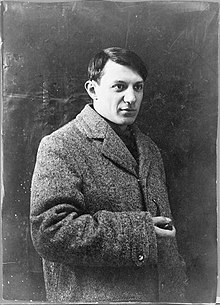Pablo Picasso
Spanish painter and sculptor (1881–1973) / From Wikipedia, the free encyclopedia
Dear Wikiwand AI, let's keep it short by simply answering these key questions:
Can you list the top facts and stats about Pablo Picasso?
Summarize this article for a 10 years old
Pablo Ruiz Picasso[lower-alpha 1][lower-alpha 2] (25 October 1881 – 8 April 1973) was a Spanish painter, sculptor, printmaker, ceramicist and theatre designer who spent most of his adult life in France. One of the most influential artists of the 20th century, he is known for co-founding the Cubist movement, the invention of constructed sculpture,[8][9] the co-invention of collage, and for the wide variety of styles that he helped develop and explore. Among his most famous works are the proto-Cubist Les Demoiselles d'Avignon (1907) and the anti-war painting Guernica (1937), a dramatic portrayal of the bombing of Guernica by German and Italian air forces during the Spanish Civil War.
Pablo Picasso | |
|---|---|
 Picasso in 1908 | |
| Born | Pablo Diego José Francisco de Paula Juan Nepomuceno María de los Remedios Cipriano de la Santísima Trinidad Ruiz y Picasso[1] (1881-10-25)25 October 1881 |
| Died | 8 April 1973(1973-04-08) (aged 91) Mougins, France |
| Resting place | Château of Vauvenargues 43.554142°N 5.604438°E / 43.554142; 5.604438 |
| Education | |
| Years active | 1897–1973 |
| Known for | Painting, drawing, sculpture, printmaking, ceramics, stage design, writing |
| Notable work |
|
| Movement | Cubism, Surrealism |
| Spouses | |
| Partners |
|
| Children |
|
| Family |
|
| Awards | |
| Patron(s) | |
| Signature | |
 | |
Picasso demonstrated extraordinary artistic talent in his early years, painting in a naturalistic manner through his childhood and adolescence. During the first decade of the 20th century, his style changed as he experimented with different theories, techniques, and ideas. After 1906, the Fauvist work of the older artist Henri Matisse motivated Picasso to explore more radical styles, beginning a fruitful rivalry between the two artists, who subsequently were often paired by critics as the leaders of modern art.[10][11][12][13]
Picasso's output, especially in his early career, is often periodized. While the names of many of his later periods are debated, the most commonly accepted periods in his work are the Blue Period (1901–1904), the Rose Period (1904–1906), the African-influenced Period (1907–1909), Analytic Cubism (1909–1912), and Synthetic Cubism (1912–1919), also referred to as the Crystal period. Much of Picasso's work of the late 1910s and early 1920s is in a neoclassical style, and his work in the mid-1920s often has characteristics of Surrealism. His later work often combines elements of his earlier styles.
Exceptionally prolific throughout the course of his long life, Picasso achieved universal renown and immense fortune for his revolutionary artistic accomplishments, and became one of the best-known figures in 20th-century art.